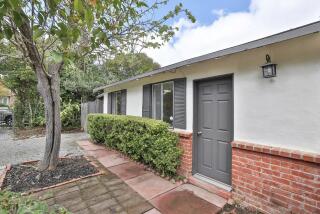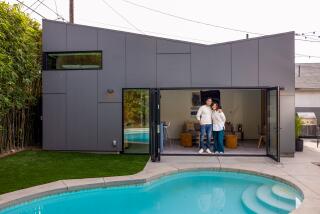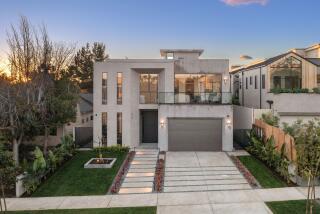‘Tiny houses’ are growing in popularity
- Share via
BALTIMORE — Greg Cantori plans to downsize when he retires. Really, really downsize.
His retirement home is 238 square feet — one-tenth the size of the average new American house — and sits in his Maryland yard. He and wife Renee can hitch it to a truck and take it with them wherever they go.
“It’s so cheap — that’s what’s so cool about this,” said Cantori, 52, who envisions a surf-and-turf future, alternating between the house and a sailboat. “We bought the house for $19,000. We can live an extraordinary life for very little money.”
It’s an example of the “tiny house” movement, which has collected a small but growing group of adherents.
Some like the freedom from a big mortgage and high energy bills. Some like the freedom from roomfuls of stuff. And some see tiny houses as a promising option for workers whose rent overwhelms their paychecks.
Tiny houses fall into two categories. Some, like Cantori’s, are technically road-ready travel trailers. Others have foundations and aren’t going anywhere.
The houses usually manage a lot of function in a little bit of space — kitchen, bedroom, bathroom, laundry room — and they’re often cute to boot. Gables. Wood siding. Even porches.
“These are beautiful works of art,” said Joe Coover with Tumbleweed Tiny House Co., a Sonoma, Calif., firm that sells homes as small as 65 square feet. The company also sells tiny-home designs.
U.S. houses got bigger for decades, ballooning from an average of a little less than 1,700 square feet in the early 1970s to 2,500 square feet last year, even as household sizes shrank, according to Census Bureau figures.
But the housing crash, foreclosure crisis and rough recession have pressed some people to think differently about how much space they need.
Whether you can actually live in a tiny home depends on more than your ability to pare down your possessions.
Location matters. Zoning, building codes, health codes and even private covenants in subdivisions can effectively render a tiny house illegal.
Tiny houses aren’t the only example of small living. “Micro-apartments” of a few hundred square feet also are popping up.
The cost for a tiny house varies. Coover, a workshop host with Tumbleweed Tiny House, said the company’s ready-made homes sell for about $40,000 to $60,000. But people who buy plans, purchase materials at a home-improvement store and build it themselves will probably spend $18,000 to $20,000, including appliances, he said.
Of course, that doesn’t include the cost of land on which the houses sit. Some tiny-house folks buy. Some rent. Some find people with extra space that they don’t mind sharing.
In Cantori’s case, his tiny house is sitting near in his Pasadena, Md., yard, behind his less-than-palatial 1,400-square-foot residence.
Smith writes for the Baltimore Sun.
More to Read
Inside the business of entertainment
The Wide Shot brings you news, analysis and insights on everything from streaming wars to production — and what it all means for the future.
You may occasionally receive promotional content from the Los Angeles Times.










